Before purchasing a pressure sensor, there are a number of application questions you will need to answer to ensure it is fit for purpose.
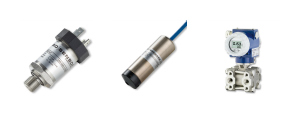
Pressure sensors are complex electromechanical devices with many optional design features for a multitude of applications. You will need to know specific details of the intended application conditions in order to choose the most appropriate pressure sensor for compatibility with the installation and operational requirements.
Pressure Range
What will be the highest and lowest measured pressure? [guide]
Typically most pressure sensors are specified with ranges from 0 to a full scale positive pressure. Compound ranges like -1 to 2 bar which incorporate vacuum and positive pressure range into one sensor are also often required.
Reference Pressure
What pressure will the measurements be referenced to? [guide]
Is the pressure measured with respect to barometric pressure, perfect vacuum or some other pressure. The main three reference types are gauge, absolute and differential.
Overpressure
What is the highest pressure that could be generated by the process during normal or abnormal operational conditions? [guide]
All pressure sensors have an overpressure and burst pressure limit that must not be exceeded to avoid a shift in calibrated accuracy or mechanical damage to the sensor.
Media Type
What liquid/gas is being measured? [guide]
The materials in contact with the liquid or gas must be able to withstand long term exposure to the process media over the operating pressure and temperature range, without significant degradation of performance or damage to the pressure sensor.
Featured pressure sensor products
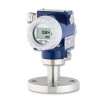 XMPi Process Plant Gauge and Absolute Pressure Transmitter - Process transmitter for measuring vacuum, steam, food, pharmaceutical, oil, gas and other pressure readings necessary for the monitoring and control of bulk production processes.
XMPi Process Plant Gauge and Absolute Pressure Transmitter - Process transmitter for measuring vacuum, steam, food, pharmaceutical, oil, gas and other pressure readings necessary for the monitoring and control of bulk production processes.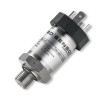 Lube oil pressure sensor for use on ship engines to measure up to 10 bar - Marine approved pressure sensor for use on lube oil up to 10 bar with a maximum media temperature of 125°C and environment temperature of 85°C.
Lube oil pressure sensor for use on ship engines to measure up to 10 bar - Marine approved pressure sensor for use on lube oil up to 10 bar with a maximum media temperature of 125°C and environment temperature of 85°C.
Media Temperature Range
What is the max/min temperature of the liquid or gas being measured? [guide]
The sensing technology in contact with the media will have an upper and lower temperature limit which if exceeded may damage the pressure sensor.
The pressure sensor signal conditioning electronics which are normally fitted further away from the media are more affected by the immediate environment temperature, and electronic circuits can be physically damaged by excessive high or low temperature that exceed specification limits.
Environmental Conditions
What are the surrounding environmental conditions?
The pressure sensor should be able to tolerate the expected range of ambient temperatures, electromagnetic interference, vibration and shock, and if used outside or where dust levels are high, the pressure sensor should have the appropriate level of IP rated protection.
In special cases extra components maybe required such as lightning protection circuitry.
Signal Output
Which type of electrical measurement signal is required? [guides]
This will be dependent on the type of input accepted by the instrumentation connected to the pressure sensor. The most common output types are 4-20mA current loop, 0-10vdc amplified voltage and mV/V strain gauge.
Power Supply
What is the range of supply voltage available?
The majority of pressure sensor are powered by a low DC voltage such as 5V, 10V or 24Vdc, and many allow a range of voltages above and below the nominal value. Some pressure sensors particularly those that are ratiometric will require a regulated supply voltage.
Featured pressure sensor products
 600 bar, 9000 psi, 60 MPa Pressure Sensors, Transducers & Transmitters - High pressure range sensors with a measurement range from 0 to 600 bar, 9000 psi, or 60 MPa.
600 bar, 9000 psi, 60 MPa Pressure Sensors, Transducers & Transmitters - High pressure range sensors with a measurement range from 0 to 600 bar, 9000 psi, or 60 MPa.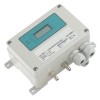 100 Pa bi-directional range differential air pressure transmitter - Bi-directional low range 4 to 20 milliamp differential pressure transmitter covering an air pressure range from -100 to +100 pascals, for cleanrooms, isolation rooms, and filter monitoring.
100 Pa bi-directional range differential air pressure transmitter - Bi-directional low range 4 to 20 milliamp differential pressure transmitter covering an air pressure range from -100 to +100 pascals, for cleanrooms, isolation rooms, and filter monitoring.
Measurement Accuracy
How accurate do you need the pressure reading to be? [guide]
The accuracy of a pressure sensor can be broken down into four main contributing factors of uncertainty
- Room temperature accuracy – linearity, hysteresis & repeatability (LHR)
- Zero & Span setting
- Thermal errors
- Long term stability
Electrical Connection
How will the power supply and signal wires be connected? [guides]
The electrical connection provided is typically either a plug & socket for easy removal of cable or sensor from an installation, or a cable gland which prevents separation of pressure sensor and cable but safeguards against tampering.
The main factors influencing the type of electrical connector used are the preferred standard in the industry used (e.g. Automotive = M12 connector, Aerospace = Bendix) or the level of ingress protection required (e.g. Submersible = IP68 cable gland).
Process Connection
What mechanical process fitting is required to install the sensor? [guides]
How the pressure sensor is mounted will depend a lot on the type of media being measured, available access points to the system being measured and country specific conventions.
If the application is pharmaceutical, food or beverage then a Dairy or Tri-clamp flange fitting would be needed.
If a process plant has standardised on valve block & bleed manifolds that all have a 1/4 NPT internal thread, then a pressure sensor with a 1/4 NPT male thread would be the preferred choice.
Some countries and geographic regions will lean towards a type of thread, for example National Pipe Thread Taper NPT is very common in the USA, but British Standard Pipe Thread (BSP) is the preferred choice in the UK.
Certification
Are there any special requirements such as ATEX or marine certificates?
Some applications require the product to be certified for use in certain locations such as on a ship (DNV marine approval) or in a hazardous area where there is an explosion risk (ATEX or IECEx certified).
The application may require that the product has been built or tested to a particular standard which is critical to the intended use, for example, reducing probability of electronics failure (Safety Integrity Level – SIL2 approval) or to ensure accuracy performance (UKAS accredited calibration cert).
Featured pressure sensor products
 DMK 331 Ceramic Diaphragm Industrial Pressure Transmitter - This pressure transmitter can be supplied with a PVDF process connector so that it can be used to measure the pressure of acids and other corrosive chemicals.
DMK 331 Ceramic Diaphragm Industrial Pressure Transmitter - This pressure transmitter can be supplied with a PVDF process connector so that it can be used to measure the pressure of acids and other corrosive chemicals.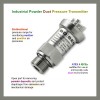 Air classification system powder duct pressure transmitter with +/-15 kPa range and ATEX/IECEx IS cert - This pressure transmitter with open port design is ideal for monitoring duct pressures in powder air classification systems. It features ATEX/IECEx IS certification and a -15 to +15 kPa range.
Air classification system powder duct pressure transmitter with +/-15 kPa range and ATEX/IECEx IS cert - This pressure transmitter with open port design is ideal for monitoring duct pressures in powder air classification systems. It features ATEX/IECEx IS certification and a -15 to +15 kPa range.
Summarised Checklist
Define your pressure sensor requirements using this checklist:
- Pressure range?
- Reference pressure?
- Overpressure?
- Media type?
- Media temperature range?
- Environmental conditions?
- Signal output?
- Power supply?
- Measurement accuracy?
- Electrical connection?
- Process connection?
- Certification?
Related Help Guides
- Supply voltage and load resistance considerations for pressure transmitters
- Pressure Sensor Accuracy Specifications
- How to Connect a 4-20mA Current Loop Pressure Transmitter
- Symptons and Causes of Damage to Pressure Transducer Diaphragms
- What is difference between working, burst and over pressure
- Measuring vacuum as a negative gauge pressure using a dp sensor
- Measuring liquid level in a tank using a dp sensor
- Measuring density of a liquid using a dp sensor
- Pressure Sensor Technology Comparative Guide
Related Technical Terms
- Ceramic Pressure Sensors
- Digital Compensation
- Dry Cell
- Dry/Dry
- HART®
- Isolation Diaphragm
- LVDT – Linear Variable Differential Transformer
- Pressure Sensors
- SOI – Silicon on Insulator
- Stainless Steel Pressure Sensors
- Static Line Pressure
- Wet/Dry
- Wet/Wet
Related Online Tools
- Pressure Transmitter 4-20mA Current Output Calculator
- Pressure Sensor Calculator
- DP Flow Transmitter Output Calculator
- Pressure Transducer Millivolt (mV) Output Calculator
- Pressure Transducer 0-10V Voltage Output Calculator
- Pressure Transducer 0-5V Voltage Output Calculator
- Pressure Transducer 1-5V Voltage Output Calculator
- Pressure Transducer 0.5-4.5V Voltage Output Calculator
- Pressure Sensing Errors Calculator
- Pressure Transmitter 0-20mA Current Output Calculator

